Trees Birds Mammals Fish Amphibians Reptiles
Wild Algarve
Bookshop
Clavulina rugosa (Bull.) J. Schröt. - Wrinkled Club
Phylum: Basidiomycota - Class: Agaricomycetes - Order: Cantharellales - Family: Clavulinaceae
Distribution - Taxonomic History - Etymology - Identification - Culinary Notes - Reference Sources
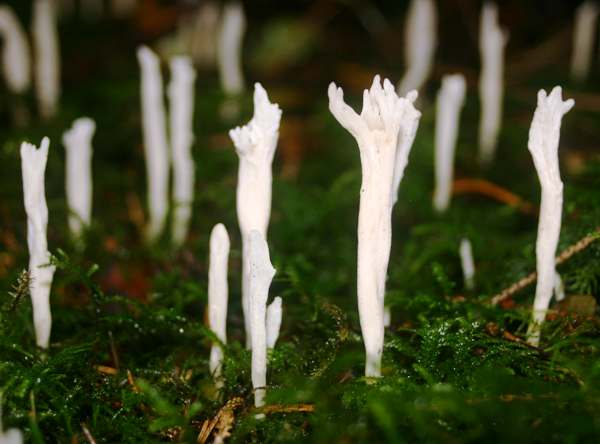
This small club fungus is often solitary or in scattered
groups among the moss beside woodland footpaths. The club is flattened in cross section and
has very few irregularly-shaped branches. The branch tips are blunt rather than having pointed tips as other white clubs, such as Clavaria fragilis (White Spindles) do.
Seen on a misty day in dark woodland, these strange little fungi with - Classic 'ghostly forms' might just send a fertile imagination racing.
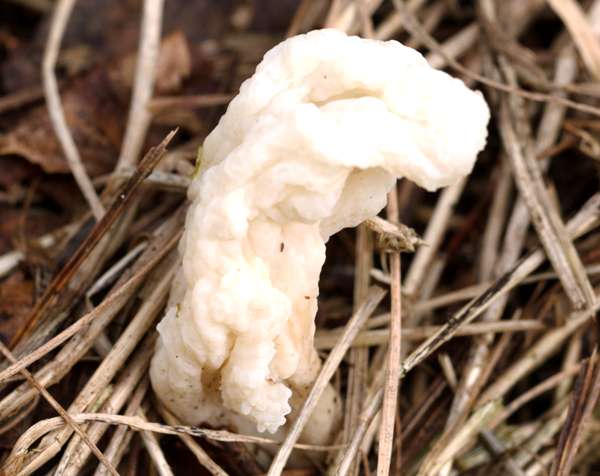
Above: This fine specimen definitely deserves the adjective 'wrinkled' in it common name.
Distribution
Very common in woodlands in most parts of mainland Britain and Ireland, as indeed it is in most other parts of northern Europe, Clavulina rugosa seems to be much rarer in the warmer countries of southern Europe. This species is also recorded in North America and in many other temperate parts of the world.
Taxonomic history
The Wrinkled Club was described in 1790 by French mycologist Jean Baptiste Francois (Pierre) Bulliard, who gave it the binomial scientific name Clavaria rugosa. Nearly a century later, in 1888, German mycologist Joseph Schrötter (1837 - 1894) transferred this species to the genus Clavulina, thereby establishing its currently-accepted scientific name Clavulina rugosa.
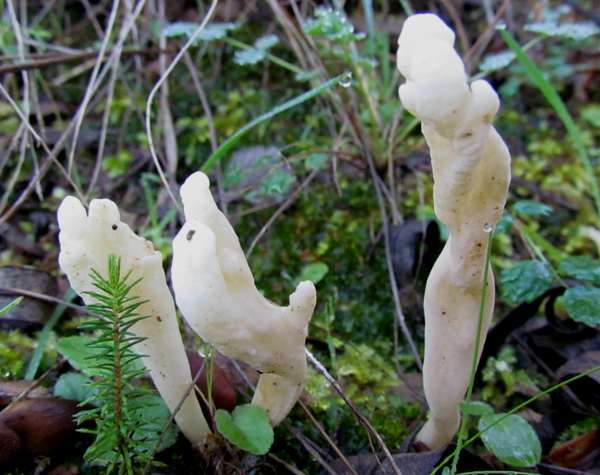
The many synonyms of Clavulina rugosa include Clavaria rugosa var. alcyonaria Corner, Clavaria rugosa Bull., Clavaria grossa Pers., Clavaria canaliculata Fr., Ramaria rugosa (Bull.) Gray, Clavaria rugosa var. fuliginea Fr., Clavaria macrospora Britzelm., Clavulina rugosa var. alcyonaria Corner, Clavulina rugosa var. canaliculata (Fr.) Corner, Clavulina rugosa var. fuliginea (Fr.) Corner, and Clavulina rugosa var. macrospora (Britzelm.) Corner.
Etymology
The specific epithet rugosa means wrinkled or rough.
The picture above shows not only how varied in form the Wrinkled Club can be but also just how gregarious these little fairy clubs are. Although they are easy to see, often it is impossible to walk on the forest floor without treading upon some of the fruitbodies.
Identification guide
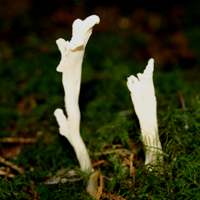 |
Fruitbody
Because the stem and the fertile upper
section of the fruitbody are the same colour - white or cream or
occasionally light grey - there is no clear delineation between the infertile and
fertile surfaces. Some examples of this fungus branch but rarely spread out
significantly, and many do not branch at all.
The bluntish tips, which have wrinkled and uneven
surfaces surfaces, are laterally compressed but not forked, and are usually 5 to 12cm tall. |
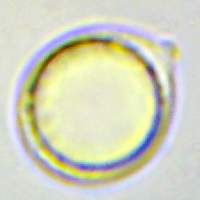 |
Spores
Broadly ellipsoidal to subglobose, smooth, 8.5-13.5 x 7.8-12µm; inamyloid.
Spore print
White. |
Odour/taste |
Not distinctive. |
Habitat & Ecological role |
Considered to be mycorrhizal, singly or in small groups on the ground
beneath deciduous and coniferous trees; very often beside footpaths. |
Season |
August to December in Britain and Ireland. |
Similar species |
Clavulina cinerea is a
grey, branching fungus that does not have the characteristic surface
wrinkles of Clavulina rugosa. |
Culinary Notes
The Wrinkled Club is reported to be edible, but its small size mean that there is little temptation to try gathering and eating this insubstantial woodland fungus.
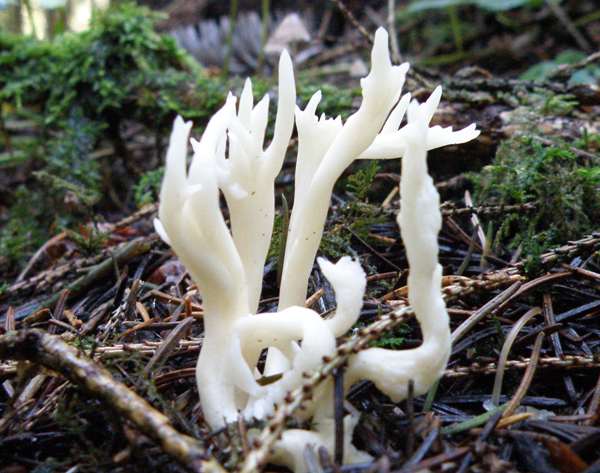
Above: Some specimens have sharpish tips more reminiscent of Crested Coral Clavulina coralloides.
Reference Sources
Fascinated by Fungi, 2nd Edition, Pat O'Reilly 2016, reprinted by Coch-y-bonddu Books in 2022.
Dictionary of the Fungi; Paul M. Kirk, Paul F. Cannon, David W. Minter and J. A. Stalpers; CABI, 2008
Taxonomic history and synonym information on these pages is drawn from many sources but in particular from the British Mycological Society's GB Checklist of Fungi.
Acknowledgements
This page includes pictures kindly contributed by Simon Harding, and Beverley and Ivan Stafford.
Top of page...
Fascinated by Fungi. Back by popular demand, Pat O'Reilly's best-selling 450-page hardback book is available now. The latest second edition was republished with a sparkling new cover design in September 2022 by Coch-y-Bonddu Books. Full details and copies are available from the publisher's online bookshop...